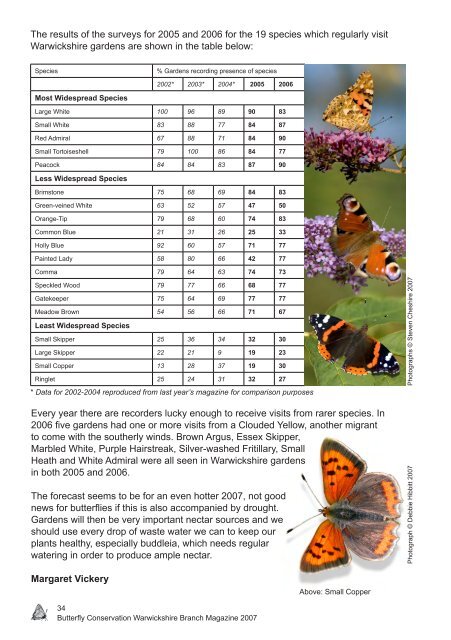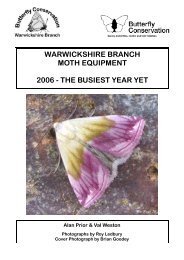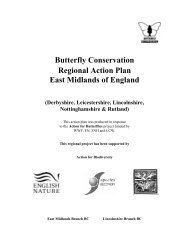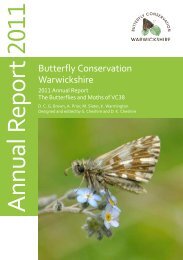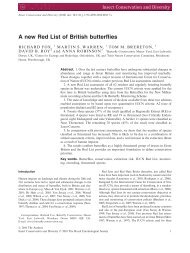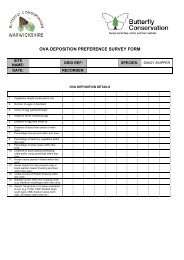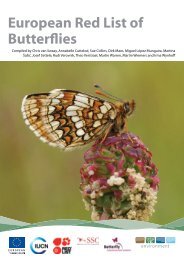2007 Magazine Version 05.indd - Butterfly Conservation Warwickshire
2007 Magazine Version 05.indd - Butterfly Conservation Warwickshire
2007 Magazine Version 05.indd - Butterfly Conservation Warwickshire
Create successful ePaper yourself
Turn your PDF publications into a flip-book with our unique Google optimized e-Paper software.
The results of the surveys for 2005 and 2006 for the 19 species which regularly visit<br />
<strong>Warwickshire</strong> gardens are shown in the table below:<br />
Species<br />
% Gardens recording presence of species<br />
2002* 2003* 2004* 2005 2006<br />
Most Widespread Species<br />
Large White 100 96 89 90 83<br />
Small White 83 88 77 84 87<br />
Red Admiral 67 88 71 84 90<br />
Small Tortoiseshell 79 100 86 84 77<br />
Peacock 84 84 83 87 90<br />
Less Widespread Species<br />
Brimstone 75 68 69 84 83<br />
Green-veined White 63 52 57 47 50<br />
Orange-Tip 79 68 60 74 83<br />
Common Blue 21 31 26 25 33<br />
Holly Blue 92 60 57 71 77<br />
Painted Lady 58 80 66 42 77<br />
Comma 79 64 63 74 73<br />
Speckled Wood 79 77 66 68 77<br />
Gatekeeper 75 64 69 77 77<br />
Meadow Brown 54 56 66 71 67<br />
Least Widespread Species<br />
Small Skipper 25 36 34 32 30<br />
Large Skipper 22 21 9 19 23<br />
Small Copper 13 28 37 19 30<br />
Ringlet 25 24 31 32 27<br />
* Data for 2002-2004 reproduced from last year’s magazine for comparison purposes<br />
Every year there are recorders lucky enough to receive visits from rarer species. In<br />
2006 five gardens had one or more visits from a Clouded Yellow, another migrant<br />
to come with the southerly winds. Brown Argus, Essex Skipper,<br />
Marbled White, Purple Hairstreak, Silver-washed Fritillary, Small<br />
Heath and White Admiral were all seen in <strong>Warwickshire</strong> gardens<br />
in both 2005 and 2006.<br />
The forecast seems to be for an even hotter <strong>2007</strong>, not good<br />
news for butterflies if this is also accompanied by drought.<br />
Gardens will then be very important nectar sources and we<br />
should use every drop of waste water we can to keep our<br />
plants healthy, especially buddleia, which needs regular<br />
watering in order to produce ample nectar.<br />
Photographs © Steven Cheshire <strong>2007</strong><br />
Photograph © Debbie Hibbitt <strong>2007</strong><br />
Margaret Vickery<br />
Above: Small Copper<br />
34<br />
<strong>Butterfly</strong> <strong>Conservation</strong> <strong>Warwickshire</strong> Branch <strong>Magazine</strong> <strong>2007</strong>


